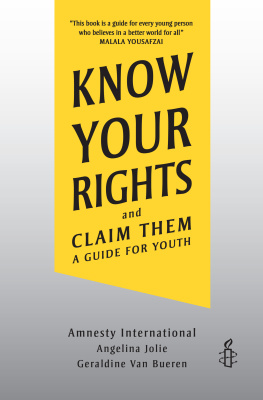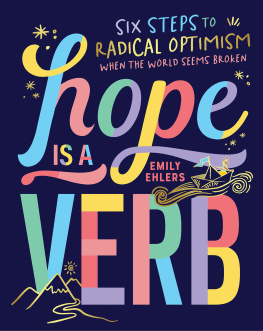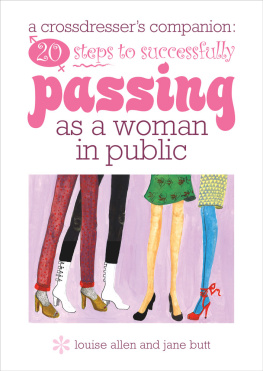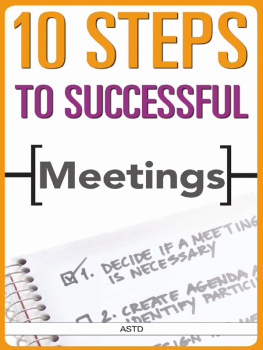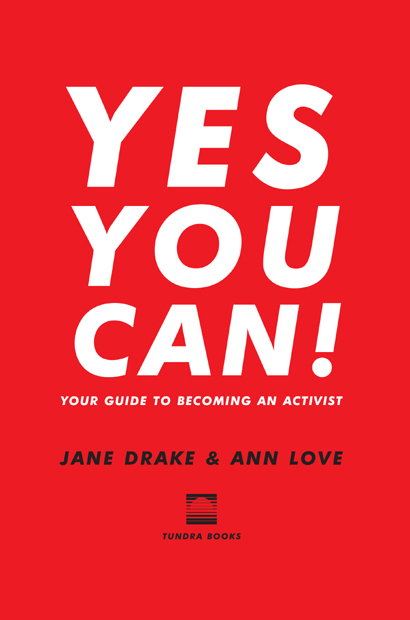Copyright 2010 by Jane Drake & Ann Love
Published in Canada by Tundra Books,
75 Sherbourne Street, Toronto, Ontario M5A 2P9
Published in the United States by Tundra Books of Northern New York,
P.O. Box 1030, Plattsburgh, New York 12901
Library of Congress Control Number: 2009938089
All rights reserved. The use of any part of this publication reproduced, transmitted in any form or by any means, electronic, mechanical, photocopying, recording, or otherwise, or stored in a retrieval system, without the prior written consent of the publisheror, in case of photocopying or other reprographic copying, a licence from the Canadian Copyright Licensing Agencyis an infringement of the copyright law.
Library and Archives Canada Cataloguing in Publication
Drake, Jane
Yes you can!: your guide to becoming an
activist / Jane Drake, Ann Love.
eISBN: 978-1-77049-235-6
1. Social changeJuvenile literature. 2. Social actionJuvenile literature. I. Love, Ann II. Title.
HN18.3.D73 2010 j361.2083 C2009-905847-2
We acknowledge the financial support of the Government of Canada through the Book Publishing Industry Development Program (BPIDP) and that of the Government of Ontario through the Ontario Media Development Corporations Ontario Book Initiative.
We further acknowledge the support of the Canada Council for the Arts and the Ontario Arts Council for our publishing program.
v3.1
For the change-makers in our immediate
family, whose work in social justice
is a daily inspiration
Stephanie Drake,
David Love, and Jennifer Love
Acknowledgments
With thanks to
Mike Balkwill; Henry, Ian, and William Barnett; Patrick Barnett; Kim Beatty; Lee Ann Boop; Tim Borlase; Catherine Bradley; Barbara Cochrane; Jane Crist; Brian, Jim, and Madeline Drake; Emily Drake; Kayode Fatoba; David Furlong; John Giles; Monte Hummel; Brian and Ruth Kelly; Mikaela Lefaive; Adrian and Melanie Love; Gage Love; Geoff and Kate Love; Garfield Mahood; David Morley; Michael Perley; Evan, Luke, and Olivia Racine; Mark, Mason, and Sadie Salmoni; David Sorek; David Spedding; and Mary Thompson.
Many thanks to Kathy Lowinger and Sue Tate, who enthusiastically endorsed this book and helped us step up to a different readership. Thanks also to the Tundra teamwe wouldnt change a thing about you!
Authors Note
In the timeline, we use modern place names, such as Iran and Italy, followed by the historical names of peoples, such as the Persians and the Spartans. Where we couldnt pinpoint an exact date, we selected one mid-timeframe and used the symbol c for circa to indicate that our date is approximate.
CONTENTS
introduction
STEP RIGHT UP!
I magine a world where whalers are allowed to kill whatever moves on the high seas. Or a town where only one race of people can sit in the front seats of the bus. Or a high school where cigarette companies can market their products to students. What if young people could be thrown into prison for what they believe or for even what they wear to school? What if preteens could be forced to work in factories if their parents needed money instead of attending school?
Are these nightmare imaginings? Nothese things happened in many parts of the world until recent times and, in some places, happen still. And where change has ended these nightmares, determined people made the difference. Who were these change-makers and how did they do it? Read on
Maybe you, too, see something that needs to change. Or have a dream for a better world and want to work towards it. If that is you, read on
This book divides the process of change into nine steps. Each step is introduced with a dramatic story of change on a major issue to highlight the step itself. Then useful strategies and skills, critical to fulfilling every step, are offered. A historical timeline of milestones and setbacks puts the magnitude of the change into context.
Start where you may be right nowIm Fed Up. Has something grabbed your attention and hit you in the gut? You may feel sickened, irritated, or totally annoyed. STEP ONE asks you to take a breath, look inwards, and galvanize your negative feelings into positive action.
STEP TWO Whats Wrong?helps you pinpoint the problem, research it, then state it clearly.
Great Minds Think Alike, STEP THREE, suggests you find out who is already working on the same thing and who your supporters are. What might you expect with a partnership or coalition? What are the ups and downs of working with others? How can you identify and cultivate the opposition?
A baseball personality, Branch Rickey, once said, Luck is the residue of design. STEP FOUR looks at the relationship between hard work and luck in Good Plans, Good Luck.
Some changes come about more easily by setting one attainable goal after another. STEP FIVE investigates Baby Steps, Giant Leaps.
And when the road gets rocky, Butting Heads offers ways to manage a power struggle successfully in STEP SIX.
STEP SEVEN, When the Going Gets Tough, the Tough Get Going, helps you stick with it, even when the challenge becomes personal.
Then, STEP EIGHT inspires you with innovative ways of Getting Heard if your cause gets mired in red tape, apathy, or disinterest.
And STEP NINE looks at Life after Change, when the excitement of pioneering is over but the work must continue.
These nine steps follow a useful sequence, but the order may vary in a real campaign. Or you may be better at blazing your own trail than following someone elses template step-by-step. No matter what your style, you can be successful when you listen to your heart, develop a solid vision for a better future, and empower yourself through knowledge and action.
You can begin with a simple projectsuch as improving the cleanliness of the bathrooms at school, or removing invasive plants from a neighborhood park. Or you can start with a larger campaignsuch as persuading your local school or community to dramatically reduce their carbon footprint. Even if you start small, you will make a difference, and you will learn how to be more effective next time.
Imagine a world where global warming has stopped; every child goes to bed well nourished; forests grow back faster than they are being cut down; people are respectful to each other; torture and war have disappeared; there are no prisoners of conscience anywhere; everyone enjoys health care, education, clean water, and fresh airthe possibilities are endless. Daydreams or future realities? Go for it!
step one
IM FED UP
P eter Benenson was furious. On November 19, 1960, while riding the London Underground and reading the newspaper, he came across a story that shocked his deepest, personal ideals.
A lawyer, Peter believed fiercely in the rights and freedoms of all people. An Englishman, he was proud of his countrys part in formulating the United Nations Universal Declaration of Human Rights. That declaration, passed twelve years earlier, asserted the rights held by every person on Earth, including the right to freedom of speech. Peter knew cruel, dictatorial, and repressive governments secretly, and sometimes openly, imprisoned citizens that spoke out against their policieseven governments that voted for the declaration. He read about it all the time. But a standard had been set, which, in the long run, should prevail.


